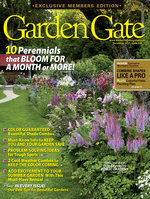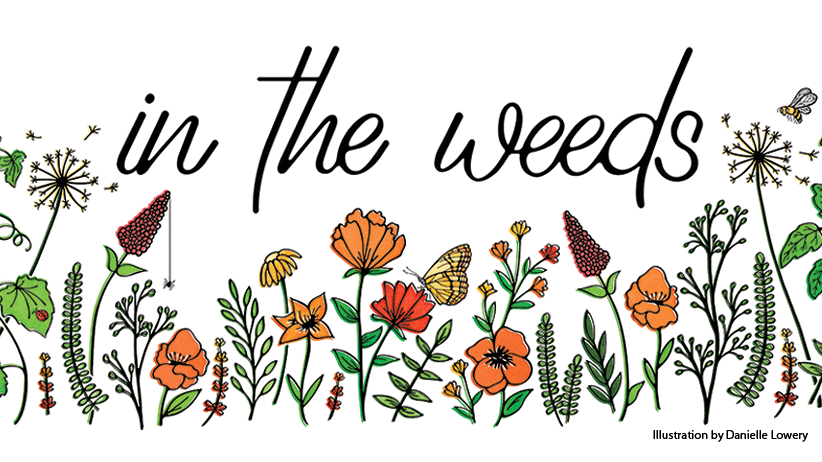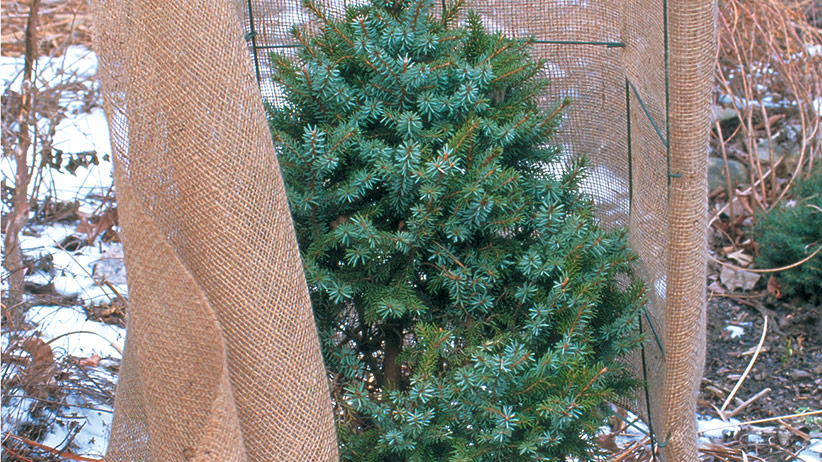
The lowdown on the fall garden cleanup
The days are getting shorter, the nights cooler; your plants are starting to wind down, and after the effort of growing a garden all spring and summer, you’re ready to rest too. But the sight of plants dying back and leaves falling spurs a plethora of different responses in gardeners. Do you go out for a final hurrah of tending the plants? Or do you simply sit back and let the garden put itself to bed? Is there really a method to the madness?
It’s safe to say there are many methods, backed by a variety of philosophies. So I asked several accomplished gardeners to share the details of their hows and whys of cleaning up the garden in the fall. Whether you want a habitat for wildlife, something nice and tidy, or a healthy environment for your plants to grow, you’ll probably find a gardener who aligns with your garden goals and habits.
From raking it all up to leaving it be, you’ll hear about one extreme to the other, and a little bit of everything in between—and there are good reasons for every approach. Read six widely variant responses, and you can rest assured about one thing: There’s no one right way to do it! Weigh the pros and cons presented here, and find which method is best for your garden’s needs.
You Might Also Like:
Support Wildlife With ‘Southern Cross’ Ironweed
Fall Garden Checklist
4 Ways to Prep Your Garden in Fall for a Better Spring

Prevent the possibility of pests with fall garden cleanup
David Trinklein | Associate Professor of Horticulture, University of Missouri
If you’ve fought the disheartening battle against pests and disease in the garden, then you might feel an urgency to keep them out. A professor of horticulture at the University of Missouri, Dr. David Trinklein practices integrated pest management (IPM), a comprehensive approach to controlling pests that seeks to reduce the use of pesticides.
No home for pests
Cleaning up the garden is key to not only removing infestations, but preventing invasions in the first place. Even if you think you don’t have a pest or disease problem, Dr. Trinklein says they are probably lurking unseen or nearby, and with the proper conditions, they can quickly multiply out of control. In his opinion, the garden needs to be thoroughly cleaned up in the fall, even if your garden is seemingly problem-free.
How clean is clean?
The main concern is that disease inoculum, pest eggs and larvae will make debris their home for the winter until they can emerge in full force in spring. So rake up all fallen leaves and debris, such as dead annuals and vegetables, and cut back all perennials to the crown. If there is any disease infecting the leaves or stems, like the peony (Paeonia spp. and hybrids) diseased with powdery mildew in the photo above, you want to remove any opportunity for it to spread or for borer pests to overwinter in pithy perennial stems. Compost dead material only if you are sure your compost pile gets hot enough to kill pests and disease (usually around 140 degrees F for multiple days). Use a compost thermometer to help you know. If you aren’t sure, bag up debris and dispose of it in the trash or city compost.
What about good bugs?
His final philosophy: We might do our pollinators a greater service by cleaning up the fall garden and taking steps to reduce the need for pesticides, which harms the pollinators in the end.
You Might Also Like:
Garden Compost Basics
Which Perennials to Clean Up This Fall
Gardener's Problem Solver's Collection

Nurture beneficial pollinators
Sarah Foltz Jordan | Pollinator Conservation Specialist, Xerces Society
Sarah works to make her garden a pollinator habitat not just because of her work for the Xerces Society, but because of the entertainment value, too. Growing more native plants and creating a habitat for wildlife means her garden is alive with busy bees and butterflies. So how does she create a pollinator’s haven? To sum it up: Don’t bother cleaning up the garden at all.
Leave the leaves
Let your leaves be (even if they fall on the lawn). You can rake a light layer up to use as mulch in your beds if you’d prefer. Chopping leaves with your mower might harm queen bees and butterfly eggs, such as the red-banded hairstreak, whose larvae also eat the leaf litter. You might be concerned about smothering out patches of grass in your lawn. But it’s actually helpful to almost 70 percent of native bees who need access to bare ground to make nests.
A motto at Xerces: Every yard should have a dead log. Many species of bees, such as mason bees and leaf-cutter bees, use decaying wood in their habitat, as well as lady beetles, fireflies, butterfly pupae and many other beneficial insects.
To cut perennials, or not to cut perennials?
Another important shelter in the garden: your perennials. Leave as many stems as possible over the winter. Perennials with pithy stems, such as bee balm (Monarda spp. and hybrids), aster (Symphyotrichum spp. and hybrids) and goldenrod (Solidago spp. and hybrids), provide nesting sites for bees. As early as you can in spring, cut back stems at a variety of heights from 6 to 24 inches. Providing a fresh cut helps bees access the stems. As small carpenter bees, yellow-faced bees and leaf-cutter bees emerge from their overwintering sites, they’ll find easy access to the cut stems, where they can make nests and raise more bees. After cutting this once, don’t cut again for risk of removing nests. Notice in the photo how the sedum’s new growth is about to overtake the old stems.
You Might Also Like:
Leaving Perennial Stems Standing for Pollinators
Native Bees Overwinter in Unexpected Places
Butterfly Host Plants

Know what you grow
Barbara Pleasant | Author of "Gardener’s Guide to Plant Diseases," "Gardener’s Bug Book" and More
Every garden is unique. That’s why Barbara, longtime gardener and author of books on garden pests and diseases and veggies, encourages concentrating on really knowing how to care for the plants you have in your garden.
Determine what you need to cut during fall cleanup
There is no one solution to keeping pests and disease out, so get to know which ones your plants and growing conditions are most susceptible to. Barbara prefers to leave most perennials standing through winter so spent stems can act as an umbrella over the crown of the plant. The tops of most perennials catch snow and shelter crowns from ice. She grows two varieties of bee balm and cuts her larger one back to a foot tall to provide enough winter protection but leaves her smaller variety uncut. Her woodland phlox (Phlox divaricata) often go through bouts of powdery mildew, some years severe, some years not at all. She keeps an eye on it but has come to trust that it’s going to be OK, so she doesn’t bother cleaning it up in the fall.
Leaf debris
Learn where pests overwinter: Cabbage worms, cabbage aphids and asparagus beetles overwinter in debris in and around the veggie garden. Remove dead material from the veggie bed and, as an extra caution, from perennial beds near the vegetables.
Cucumber beetles, Colorado potato beetles and squash bugs overwinter in bark crevices and old logs, so debris or not, some bugs may still be finding a place to live. But sometimes for Barbara, insects are a welcome sight because it means good bugs will be present, too. Leaf litter is home for pollinators and some species of snails, which attract and feed birds. Earthworms love leaves, too, and they’ll enhance the soil drainage as they break leaves down.

Make sure to mulch in fall
Teri Dunn Chace | Author of "Seeing Seeds," "How to Eradicate Invasive Plants" and More
Teri, avid gardener in New York and author, reminds all gardeners: Cleaning up the fall garden is not like cleaning up the living room. Your goal is not necessarily tidiness. Learn to appreciate the natural beauty of the fall and winter garden. Some flowers, such as coneflower (Echinacea spp. and hybrids), look amazing in the winter.
Don’t cut
In fact, Teri leaves all her perennials standing through the winter. The stems protect the plant, and if you’re growing any marginally hardy plants, as Teri often does, you’ll want that extra protection. If one of her perennials comes down with a disease, she removes the plant from the garden altogether. And, even after a first frost, a plant is still sending energy to the root system to fuel next year’s show, so cutting too soon can inhibit the plant’s performance next season.
Consider if plants are aggressive or invasive
As author of the book How to Eradicate Invasive Plants, Teri answers the question: Should you really leave the seedheads of aggressive or invasive plants? No, you should not. Remove flowers before seeds are formed and dispose of them in the trash. If you’re trying to completely remove an aggressive or invasive plant, fall is a good time to pull it. Energy levels are decreasing, and it has a harder time fighting back.
Leave no bare ground
Above all else, Teri emphasizes the importance of covering bare ground in the perennial bed. She uses mulch, which she makes herself. Her secret mulch recipe is to chop up fallen leaves and mix them with straw, leaving some leaves in piles for pollinators. This mix is relatively inexpensive, decomposes well and enriches the soil. Teri likes to mulch thickly, covering beds with 4 inches of mulch. A good layer of winter mulch can prevent aggressive plants from spreading — they’ll pounce on open ground in spring — and can help protect marginally hardy plants through the cold days. An extra perk of a nice layer of mulch in fall: It looks tidy.
Utilize perennial ground covers
Another option instead of mulch is to cover bare ground with a fast-growing but easy-to-remove perennial ground cover. Lamb’s ear (Stachys byzantina) works well in her garden. It covers a lot of space while she waits for slower-growing plants and shrubs to fill in, looks good with everything and is easily removed when she needs more room for other plants.

Clean up the fall garden over time
Alan Branhagen | Director of Operations, Minnesota Landscape Arboretum
Cleaning up the garden in the fall is a lot of work, but saving it all for spring can be just as exhausting. Alan’s advice: Don’t make a chore out of cleaning up the fall garden.
Cut down plants only when you need to
Instead of rushing out to clean it all at once, leave perennials standing. Don’t worry about cleaning them up until the stems start to flop with wind or snow, or the plant in general becomes an eyesore. Some perennials are nice to look at even as their stems turn yellow, but when it’s not so nice anymore, go ahead and cut them back. It’s fine to cut perennials in winter as long as you only cut them back to 1 foot tall. The leftover stems protect plants and provide a spot for nesting bees.
Bundle up and enjoy the process
One of Alan’s reasons for cleaning up the garden slowly is that it gives him a reason to enjoy the outdoors in the winter. If that seems shocking, Alan, who mostly gardened in Missouri until his recent move to Minnesota, says even a chilly winter garden can be enjoyed as long as you wear the right clothing! Another of his favorite parts of the winter garden is to attract birds.
Birds will come
Birds do love the nutrition from seedheads left through the winter, but some birds also love leaf litter. Alan recommends leaving leaves in the perennial bed for the sake of pollinators, but also for the birds, such as white-throated sparrows and Eastern towhees, who scratch through leaves to snack on grubs. Some leaves, such as oak (Quercus spp.), which roll up and decompose quickly, or honey locust (Gleditsia triacanthos inermis), with small leaflets, can be left whole in the garden without a worry.
But other trees, such as Norway maple (Acer platanoides) and ginkgo (Ginkgo biloba), take longer to decompose and can stick together, suppressing plants and lawn. Either plan to chop these leaves up with a mower before leaving them in your garden or avoid growing them at all.
You Might Also Like:
Permaculture Gardening Basics
Bird Garden Plan: Support Wildlife in Your Backyard
Ultimate Blooms, Butterflies & Birds

Enjoy the winter garden
Bobbie Schwartz | Landscape Designer and Author of "Garden Renovation: Transform Your Yard into the Garden of Your Dreams"
For many years, Bobbie has been working with gardeners in Ohio to help them design dream gardens and equip them with knowledge so that they can become great gardeners. Here’s a secret about Bobbie: She actually doesn’t like the term “fall garden cleanup” at all. Instead, she prefers to preserve the fall garden so that it looks good in winter.
Don’t rake the leaves in fall
Once again, fallen leaves are an important part of the garden — they are Mother Nature’s way of nurturing the soil. It may take longer than a season, but insects and microbes gradually break down the fallen leaves into a valuable humus for your soil. Don’t bother shredding them, but covering leaves with a thin layer of mulch helps hurry decomposition a bit. Only worry about raking thick piles of leaves gently away from ground cover perennials to keep them from getting smothered.
Add winter interest and protection
Not only do perennials and ornamental grasses feed and protect wildlife, they also provide incredible form and texture in winter and fall, especially when covered in snow. Don’t cut them back and they’ll serve as a visual reminder that the garden isn’t dead! The only exception is for disease. Cut the diseased stems back to the basal foliage and leave the healthy stems. Most ornamental grasses should be cut back in spring, except for bluegrasses — just comb out the dead leaves with your fingers in spring.
What about the common concern that certain plants, such as brunnera (Brunnera macrophylla), won’t be able to emerge through dead foliage in spring, or bearded iris will become infested with insects if uncut? Bobbie has never had a problem with plants emerging, and instead of growing bearded iris, she grows Siberian iris (Iris sibirica). It blooms longer, needs less maintenance and has interesting seedheads and bronzy foliage, which you can see in the photo above, in winter. If you cut back perennials in the fall, you might miss a plant’s subtle beauty in winter.
Like this Article? Subscribe to Garden Gate Magazine for More Great Gardening Information in Your Mailbox Every Season















